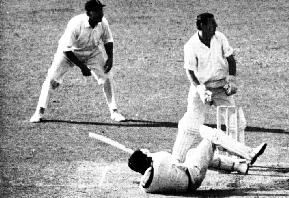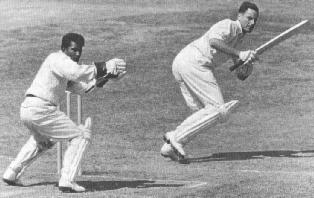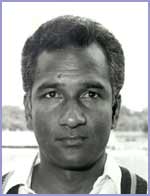According
to James, “I take Kanhai as the high peak
of West Indian cricketing development. West Indian cricketing had reached
such a stage, that a fine cricketer could be adventuresome, and Kanhai
was adventuresome…People felt that it was more than a mere description
of how he batted; it was something characteristic of us as cricketers.
They felt that it was not only a cricketing question, because Kanhai was
an East Indian, and East Indians were still somewhat looked down upon
by other people in the Caribbean. But I stated that here was a cricketer
who was doing things that nobody else was doing, and I was very pleased
when he became the captain of the West Indies side.”

A great West Indies cricketer in
his play should embody some essence of that crowded vagueness which passes for
the history of the West Indies. If, like Kanhai, he is one of the most remarkable
and individual of contemporary batsmen, then that should not make him less but
more West Indian. You see what you are looking for, and in Kanhai’s batting what
I have found is a unique pointer of the West Indian quest for identity, for ways
of expressing our potential bursting at every seam. So now I hope we understand
each other. Eyes on the ball.
The first historical innings (I prefer to call them historical now) by Kanhai was less than 50, for British Guiana against the Australians of 1956. Kanhai had nor yet made the West Indies team. He played well but what was remarkable about the innings was not only its promise but that he was the junior in a partnership with Clyde Walcott as senior.
Yet the innings in 1957 that future
events caused me to remember most strongly was his last ten innings at
the Oval. He faced Trueman and immediately hit him for two uninhabited
fours. Gone was the restrain that held him prisoner during all of the
previous innings against England.
In Australia, Frank Worrell made
West Indians and the world aware of what West Indians were capable of when their
talents had full play. That is Worrell’s gift to the West Indian personality…Knahai
continued to play that way all through the season. When he made a century in each
innings against Australia, he was within an ace of making the second century in
even time. Hunte being run out in an effort to help Kanhai towards the century,
Kanhai was so upset that it was long minutes before he could make the necessary
runs.
Kanhai continued to score, in the
West Indies, in India, in Pakistan, but the next great landmark of his career
was his innings against England at the Oval in 1963…at the Oval, with the fat
of the match depending to a substantial degree on his batting (Sobers ran himself
out) in this his last test Innings in England, Kanhai set off to do to the English
what he had done to the Australians.
1964 was a great year…all through
1964 I sat in press boxes, most often between Sir Learie Constantine and
Sir Frank Worrell. We were reporting England against Australia; there
was a lot of talking about cricket and naturally about awest Indian cricketers.
About Kanhai, for quite a while the only thing notable said was by Worrell.
He made a comparison between Kanhai and Everton Weekes as batsmen who
would stand back and lash the length ball away on the off-side or to the
on-boundary. Then at Leeds, Kanhai himself turned up and came and sat
in the press box. Learie had a long look at him and then turned to me
and said, “There is Kanhai.
You know at times he goes crazy.”
I knew that Learie had something
in mind.I waited and before long I learnt what it was. I shall try as
far as I can to put it in his own words. “Some
batsmen play brilliantly sometimes and at ordinary times they go ahead
as usual. That one," nodding at Kanhai,
“ is different from all of them. On certain days, before he goes into
the wicket, he makes up his mind to let them have it. And once he is that
way nothing on earth can stop him. Some of his colleagues in the pavilion
who have played with him for years have seen strokes that they have never
seen before: from him or anybody else. He carries on that way for 60 or
70 or 100 and then he comes back with a great innings behind him.”

At Scarborough, Kanhai
was testing out something new. Anyone could see that he was trying to sweep anything near the leg
stump round to fine-leg to beat both deep square and long-leg. He missed
the ball more than he connected. That was easy enough. But I distinctly
remember being vaguely aware that he was feeling his way to something.
I attributed it to the fact that he was playing league cricket all season
and this was his first first-class match. Afterwards, I was to recall
his careful defense of immaculate length balls from Trevor Bailey, and,
without any warning or fuss, not even a notable follow-through, he took
on the rise and lifted it ten feet over mid-on’s head to beat wide long-on
to the boundary; he never budged from his crease, he barely swung at the
ball. Yet, as far as he was concerned, it was four predestined.
We went to Edgbaston. Bailey’s side had six bowlers who had bowled for England that season. If the wicket was not unresponsive to spin, and the atmosphere not unresponsive to swing, the rise of the ball from the pitch was fairly regular. Kanhai began by giving notice that he expected test bowlers to bowl at length; balls a trifle loose so rapidly and unerringly paid the full penalty that by the time he had made 30 or 40 everyone was on his best behaviour.
Kanhai did not go crazy.
Exactly the reverse. He discovered, created a new dimension in batting. The only name I can give to it is “cat-and-mouse.” The bowler
would bowl a length ball. Kanhai would play a defensive stroke, preferably
off the front foot, pushing the ball for one, quite often for two on the
on-side—a most difficult stroke on an uncertain pitch, demanding precious
footwork and clockwork timing. The bowler, after seeing his best lengths,
exploited in this manner, would shift, whereupon he was unfailingly dispatched
to the boundary. After a time it began to look as if the whole sequence
had been pre-arranged for the benefit of the spectators. Kanhai did not
confine himself too rigidly to this pre-established harmony.
One bowler, to escape the remorseless
billiard-like pushes, brought the ball untimely up. Kanhai hit him for six to
the long-on off the front foot. The bowler shortened a bit. Kanhai in the same
over hit him for six in the same place, off the back foot this time. Dexter, who
made a brilliant, in fact, dazzling century in the traditional style, hit a ball
out of the ground over the wide mid-on. Kanhai hit one out of the ground some
40 yards further on that Dexter. He made over 170 in about three hours.
They were wrong. Kanhai
had found his way into regions Bradman never knew. It was not only the
technical skill and strategic generalship that made the innings the most
noteworthy I have seen. There was more to it, to be seen as well as felt.
Bradman was a ruthless executioner of bowlers. All through this demanding
innings Kanhai grinned with a grin that could be seen a mile away.
Cricket is an art, a means of national expression. Voltaire says that no one is so boring as the man who insists on saying everything. I have said enough…But I believe I owe it to the many who did not see the Edgbaston innings to say what I thought it showed of the directions that, once freed, the West Indian might take. The West Indian in my view embody more sharply than elsewhere Nietzsche’s conflict between the ebullience of Dionysius and the discipline of Apollo. Kanhai’s going crazy might seem to be Dionysius in us breaking loose…maybe I saw only what I was looking for. Maybe.
Rohan
Babulal Kanhai
Known
as: Rohan Kanhai
Born:December 26, 1935
Test Career: 1957 - 1973/74,
79 Tests
F/C Career: 1954/55 - 1981/82, 416 matches
Style: RHBat, RAMedPace,
WK

Profile:
Rohan Kanhai's debut for West Indies in 1957 was as an opening batsman
(and wicket keeper!). However, in the following year, on Everton Weekes' retirement,
he settled comfortably into the number three spot. In the 3rd Test against India
he made his maiden century, going on to score 256, at that time the highest test
score ever recorded in India. He had an exhilarating style and for a short time
was Captain of the West Indies.
Test Statistics:
Inns NO Runs
HS Avg 100s 50s Ct
St
137
6 6227 256
47.53 15 28 50 -
F/C
Statistics: Inns NO Runs
HS Avg 100s 50s
Ct St
669
82 28774 256 49.01
83 318 7